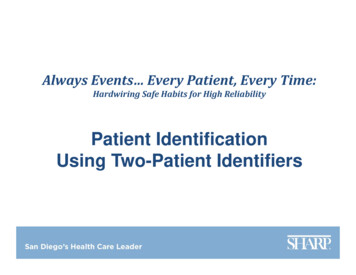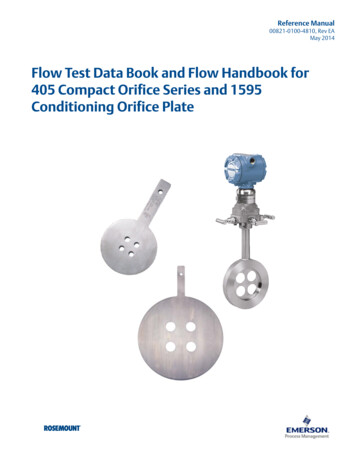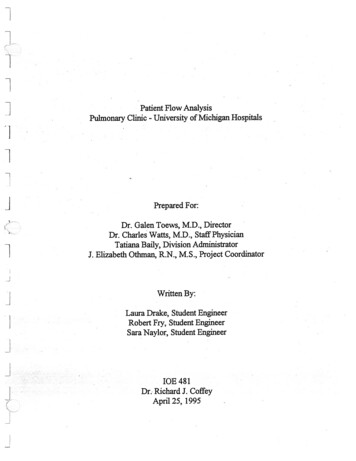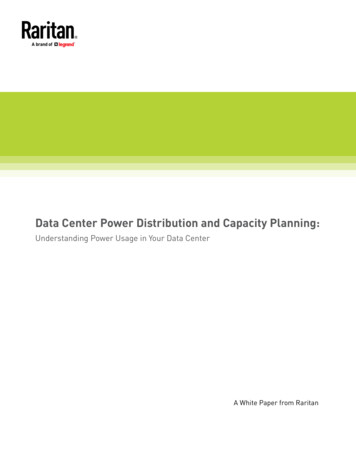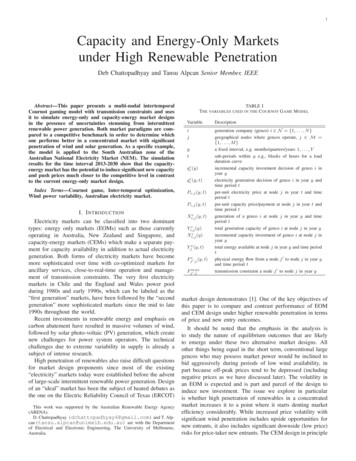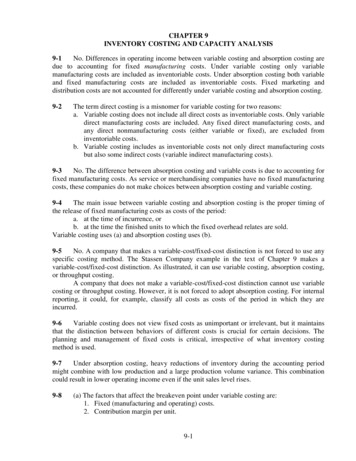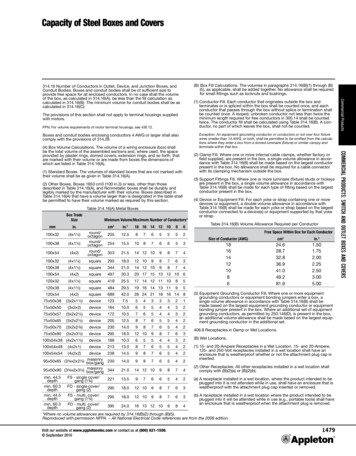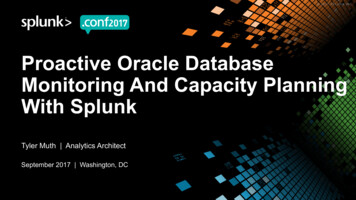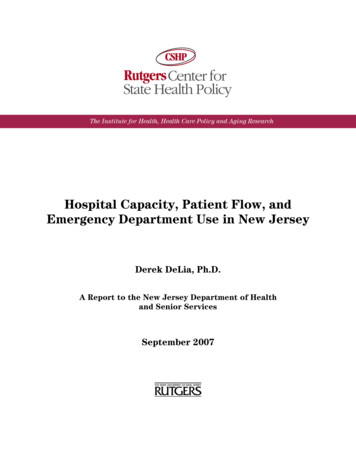
Transcription
The Institute for Health, Health Care Policy and Aging ResearchHospital Capacity, Patient Flow, andEmergency Department Use in New JerseyDerek DeLia, Ph.D.A Report to the New Jersey Department of Healthand Senior ServicesSeptember 2007June 2007Hospital Capacity, Patient Flow, and Emergency Department Use in New Jerseyi
iiRutgers Center for State Health Policy, September 2007
The Institute for Health, Health Care Policy and Aging ResearchHospital Capacity, Patient Flow, andEmergency Department Use in New JerseyDerek DeLia, Ph.D.A Report to the New Jersey Department of Healthand Senior ServicesSeptember 2007June 2007Hospital Capacity, Patient Flow, and Emergency Department Use in New Jerseyiii
ivRutgers Center for State Health Policy, September 2007
AcknowledgementsThe author gratefully acknowledges helpful comments and contributions received from anumber of officials and staff within the Department of Health and Senior Services includingDavid Gruber, Barbara Montana, Vince Yarmlak, and John Hazel. The report also benefited fromcomments and conversations with Bruce Siegel at George Washington University. Finally,important contributions were made by Cecilia Huang, Karen Jaffee, Joel Cantor, and Jeff Abramoat the Rutgers Center for State Health Policy.Hospital Capacity, Patient Flow, and Emergency Department Use in New Jerseyv
viRutgers Center for State Health Policy, September 2007
Table of ContentsExecutive Summary .ixIntroduction . . .1Literature Review .2Data Analysis . .14Case Studies . . .35Discussion .46Conclusion . 54Appendix . 55Endnotes. 59References. 61Hospital Capacity, Patient Flow, and Emergency Department Use in New Jerseyvii
viiiRutgers Center for State Health Policy, September 2007
Hospital Capacity, Patient Flow, and Emergency DepartmentUse in New JerseyDerek DeLia, Ph.D.Executive SummaryIn response to concern about growing utilization of hospital emergency departments(ED’s) and its implications for hospital surge capacity, the New Jersey Department of Health andSenior Services (NJDHSS) commissioned the study “Emergency Department Utilization andSurge Capacity in New Jersey” to be conducted by the Rutgers Center for State Health Policy(CSHP). This document is the third and final project report. It includes quantitative analysis ofrecent trends in ED utilization, hospital occupancy, ambulance diversion, and potentiallyavoidable hospital use in New Jersey (NJ). Using a case study approach, it also providesqualitative analysis of patient flow management and surge capacity planning for hospitals in thestate.After a slight drop in 2004, total ED visits in NJ resumed their previously rising trend in2005, ending the year with 3.36 million visits statewide (compared to 2.67 million in 1998). EDvisits per capita followed a similar pattern and ended 2005 with 385 visits per 1,000 residents(compared to 329 visits per 1,000 residents in 1998). Growth in ED visits is more rapid in regionsof the state that have experienced more rapid population growth, especially the Central West.But on a per capita basis, the South and Northeast regions of the state had the highest rates ofED use throughout the study period, 1998-2005.Part of the rise in ED utilization is attributable to conditions and medical episodes thatmay have been avoided through better access to primary care. A growing number of inpatientadmissions through the ED are for ambulatory care sensitive (ACS) conditions, such as asthmaand congestive heart failure. These admissions, which grew from 158,480 in 2003 to 186,284 inHospital Capacity, Patient Flow, and Emergency Department Use in New Jerseyix
2005, accounted for 31% of all ED admissions in 2005. In 2004, the state began collecting detaileddata on ED visits that did not lead to admission. Based on these data, the number of potentiallyavoidable treat-and-release ED visits grew slightly from 1.15 million in 2004 to 1.24 million in2005, accounting for 47% and 48% of all treat-and-release ED visits, respectively.Following the national trend, the hospital sector in NJ experienced declines in capacity(i.e., maintained beds) and inpatient utilization (i.e., inpatient days) from 1998 to 2005. Annualoccupancy rates at the state and regional levels fluctuated around 70% during this time. Annualoccupancy rates for intensive care and critical care units were higher than overall hospitaloccupancy during this period but usually remained below 85% leaving at least 15% of capacityavailable for unexpected patient volume.However, these annual occupancy figures give a misleading picture of the alignmentbetween the supply and demand for hospital services. Every year, individual hospitals as well asgroups of hospitals within the same geographic region experience recurring periods of very highoccupancy followed by periods of low occupancy. During peak periods, hospital capacity in NJappears to be extremely constrained. On 47 days in 2005, more than 95% of all maintained beds inthe state were occupied. This number increased from 29 days in 2004 and 11 days in 2003. Onthese days, there would be almost no immediate surge capacity available to respond to a majoremergency such as a natural disaster or terrorist attack without displacing existing patients. Onmore than ¾ of the days in 2003 through 2005, the state had less than 500 empty staffed bedsavailable per million residents, which is a surge capacity benchmark developed by the federalHealth Resources and Services Administration. Failure to meet the benchmark is more commonin some parts of the state than others. The Northwest region of NJ stands out as being the mostlikely to have a limited number of empty beds relative to population.The likelihood of experiencing high occupancy is quite varied among hospitals in thestate. In 2005, for example, 26 facilities spent more than half of the year at or above 95%occupancy of staffed beds. Other facilities experienced very high occupancy much lessxRutgers Center for State Health Policy, September 2007
frequently if at all. Yet closure of these lower-occupancy facilities could potentially overloadremaining hospitals, especially during their peak periods. The majority of informants from casestudy hospitals (5 out of 7 sites), which are representative of these higher-occupancy facilities,expressed substantial reservations about their ability to treat additional patients from closinghospitals. Since 1995, seventeen general care hospitals have closed in NJ and more closures arecurrently under consideration. While continued consolidation may be appropriate in some areas,the ability of remaining hospitals to absorb additional volume will eventually diminish as moreclosures occur.The frequency of ambulance diversion in NJ underscores the stress on capacity that isoften experienced by hospitals in the state. Data from December 2006 and January 2007 revealthat, on average, an ambulance diversion occurs once every hour in NJ. This is similar to an oftencited national statistic that there is a hospital on diversion about once every minute in the U.S.Moreover, the reported number of diversions in NJ is likely an undercount, since participation inthe state’s diversion alert system (used in this report) is not universal. Although ambulances maysometimes override hospitals’ diversion requests, these requests provide a clear signal that thehospital staff does not feel completely ready to treat additional patients.All of the case study participants agreed that better management of patient flow is crucialto avoid ambulance diversion and ED overcrowding more generally. Yet they varied substantiallyin the scale, scope, and success of their efforts. An important determinant of success inminimizing bottlenecks in the ED (and throughout the hospital) is the extent to which hospitalsare able to coordinate across “silos” within the facility. Hospitals that have been successful areable to communicate information rapidly across units and respond quickly when a particular areais reaching capacity. Other hospitals, while attempting to do this, report a greater number ofproblems in achieving this level of coordination. Some of the more crucial areas of concerninclude ability to track patients through the entire hospital in real time, coordinating dischargeHospital Capacity, Patient Flow, and Emergency Department Use in New Jerseyxi
schedules with the incoming volume of inpatients, and coordinating use of resources betweenelective surgery and ED patients.Despite the challenges faced on a daily basis, most case study participants felt that theirfacilities were reasonably well prepared to respond to a mass casualty disaster or pandemic. Allcase facilities have disaster management plans that include use of ordinarily non-clinical areasfor patient overflow and plans for early discharge of existing patients during a surge. Some ofthese plans have been tested in exercises or in some cases applied to actual events that haveoccurred in their areas (e.g., small plane crash, building fire). However, reflecting conditionsacross the nation, coordination among hospitals that do not belong to a common system appearsto be less developed.Case study hospitals vary in the way they manage potentially avoidable utilization. Somehave developed “fast track” systems to separate emergent from other cases in the ED. Two innercity facilities have responded to a large volume of ambulatory care sensitive utilization bydeveloping elaborate case management and chronic disease management systems within the EDitself. While this is a clear departure from the traditional role of the ED, these facilities havedecided that community need and patient preference have made this departure necessary. In thewords of one participant, these actions represent the “wave of the future” in ED care.NJ hospitals have also become important providers of care for mental health andsubstance abuse patients, particularly through the ED. However, case study hospitals have foundit much more difficult to provide care for these patients. In contrast to their general acceptanceof primary care patients in the ED, study participants expressed concern that their facilities areunable to provide the needed services for these patients. Patients with mental illness aredescribed as being especially difficult to treat in the ED. ED staffing and physical space are notset up to provide mental health services. This sometimes affects the care of other patients asthose requiring mental healthcare draw the attention of multiple clinicians and sometimes makeother patients feel uncomfortable. Ultimately, a general desire was expressed for health policyxiiRutgers Center for State Health Policy, September 2007
initiatives that would shift these patients out of acute care hospitals and into more appropriatesettings.Like their counterparts nationwide, hospitals in NJ face periodic stress on capacity,which often manifests itself in the form of delayed care in the emergency department (ED).These recurrent strains on capacity, more so than annualized occupancy rates, should beconsidered in evaluating the adequacy of hospital capacity in a particular community. Stress onhospitals can be understood and managed in terms of factors that affect the flow of patientsthrough the ED. Hospitals have a great deal of ability to improve patient flow through establishedtechniques of operations management.However, a variety of broader health system issues limits the extent to which hospitalscan control their patient flow. Trends in ED use are heavily influenced by the inability of patientsto gain access to primary and other specialized care (especially mental health) outside thehospital. Streamlining patient flow through the ED is often hampered by the longstandingdisparity in reimbursement for elective surgeries versus other hospital services, which makes itcostly to disrupt elective surgery schedules. In the absence of broader health system reform,hospitals will have to find ways to serve an expanding range of patients in a constrainedenvironment. Public policy efforts to assist hospitals in this task would benefit from regularsurveillance of hospital patient flow measures and other efficiency indicators.Hospital Capacity, Patient Flow, and Emergency Department Use in New Jerseyxiii
xivRutgers Center for State Health Policy, September 2007
Hospital Capacity, Patient Flow, and EmergencyDepartment Use in New JerseyDerek DeLia, Ph.D.IntroductionEmergency department (ED) utilization has been growing rapidly in the United States,overall and per capita (McCaig and Burt, 2004; Cunningham and May, 2003). Much of this growthis associated with ED visits for conditions that are either non-emergent or treatable in primarycare settings (Cunningham and May, 2003). This trend has implications beyond the ED as itsignals problems or dissatisfaction with the performance and accessibility of local primary caredelivery systems (Billings, Parikh, and Mijanovich, 2000-a).In 2006, the Institute of Medicine (IOM) released a report describing serious problemsconfronting hospital ED’s across the nation (Institute of Medicine, 2006). These include varioussigns of overcrowding such as diversion of ambulances to other hospitals, patients “boarding” inthe ED until an inpatient bed becomes available, and excessive wait times for care. The regularoccurrence of ED overcrowding raises concern about the hospital sector’s ability to respond to amass casualty event such as a terrorist attack or natural disaster. Overcrowded ED’s also createan environment where medical errors are more likely and overall quality of care is below itspotential (JCAHO, 2004).In response to concern about potential problems facing ED’s in New Jersey (NJ), the NewJersey Department of Health and Senior Services (NJDHSS) commissioned the study“Emergency Department Utilization and Surge Capacity in New Jersey” to be conducted by theRutgers Center for State Health Policy (CSHP). This document is the third and final projectreport. The first report documented trends in ED utilization and hospital bed capacity in NJ(DeLia, 2005). It also reviewed the national literature on ED utilization and overcrowding. TheHospital Capacity, Patient Flow, and Emergency Department Use in New Jersey1
second report analyzed potentially avoidable ambulatory care provided in the ED and potentiallyavoidable admissions that came through the ED (DeLia, 2006-a).This report updates analysis from the first two reports and provides additionalinformation about ambulance diversion and the management of patient flow through the ED. Thereport has four sections. The first provides an updated review of the literature on ED utilization,hospital crowding, and patient flow management. The second section provides analysis of EDutilization, hospital capacity, and ambulance diversion in NJ. The third section summarizesfindings from a series of case studies that determined how hospital ED’s and Federally QualifiedHealth Centers (FQHC’s) in NJ manage patient flow and coordinate emergency and nonemergency services. The final section provides implications and conclusions.Literature ReviewED Input, Throughput, and OutputIt is now well recognized that the ability to provide service in the ED depends on multiplefactors, most of which originate in other parts of the hospital or healthcare sector. To understandhow these factors affect ED operations, Asplin et al. (2003) developed a conceptual model thatconsists of three components: ED input, throughput, and output.ED input consists of any “condition, event, or system characteristic that contributes todemand for ED services.” Input includes demand for emergency care, urgent care, and safety netcare. Hospital ED’s across the nation have seen an increase in the demand for all three types ofcare in recent years (McCaig and Nawar, 2006). Much of this demand occurs in rapidly growingmetropolitan areas such as Phoenix, AZ and Miami, FL (Bazzoli et al., 2006). The phenomenon ofsuburban sprawl may exacerbate the effects of population growth on ED crowding. Suburbangrowth is associated with increasing rates of automobile accidents, but ED and trauma careresources are typically insufficient in these areas and lag behind population growth (Millard,2Rutgers Center for State Health Policy, September 2007
2007). This places even greater demands on urban ED’s and trauma hospitals. In addition,hospital ED’s experience an increase in demand when a nearby hospital closes its ED or ceasesoperations altogether (Sun et al., 2006).A major contributor to the growth in ED visits overall is use of the ED for non-urgentcare. This care is most frequently associated with the uninsured and patients covered byMedicaid who often face barriers to primary care. However, the majority of growth in non-urgentED visits in recent years has occurred among the privately insured (Cunningham and May, 2003).Although conclusive studies do not exist, this growth is thought to be associated with a numberof factors including difficulties in making physician appointments, the desire to receiveimmediate service without an appointment, and the desire to have tests and other procedures1done in a single location. There is also some evidence that physicians will refer patients to theED in ambiguous cases, after hours, to avoid liability risks, or when they do not have the abilityto perform recommended tests in their offices (Berenson et al., 2003; Studdert et al., 2005).In addition, a large number of people in the U.S. are aging and living longer with complexdiseases such as congestive heart failure, obstructive pulmonary disorder, kidney failure, andHIV-AIDS (Derlet and Richards, 2000). These conditions often generate acute episodes that leadto both avoidable and non-avoidable ED visits.While clinicians and researchers often classify ED use as avoidable or non-emergent,these judgments are generally difficult for patients to make. One study found that 82% of patientswith non-urgent conditions believe their situation was urgent (Gill and Riley, 1996).Misinterpretations of urgency can work in the other direction as well. A nationwide survey of EDpatients found that 5% of patients who viewed their condition as non-urgent were subsequentlyhospitalized (Young et al., 1996). Although many patients realize that non-urgent care is availablein the ED (Guttman et al., 2003), gray areas in the judgment of urgency remain important factorsin the volume and composition of ED input.Hospital Capacity, Patient Flow, and Emergency Department Use in New Jersey3
ED throughput focuses on the length of time patients spend in the ED. Throughputincludes triage, placement, and initial evaluation as well as diagnostic testing and treatmentsprovided in the ED. Throughput is often determined by the cohesiveness of caregiver teams andthe efficiency of processes used in the ED. Yet a number of broader factors can also add time topatient stays in the ED.
This document is the third and final project report. It includes quantitative analysis of . hospital use in New Jersey (NJ). Using a case study approach, it also provides qualitative analysis of patient flow management and surge capacity planning for hospitals in the state. . xii Rutger

